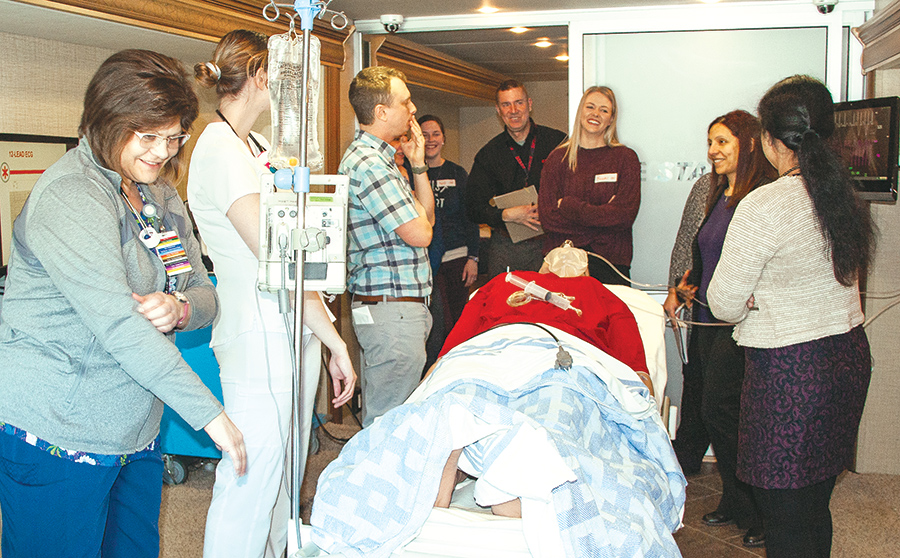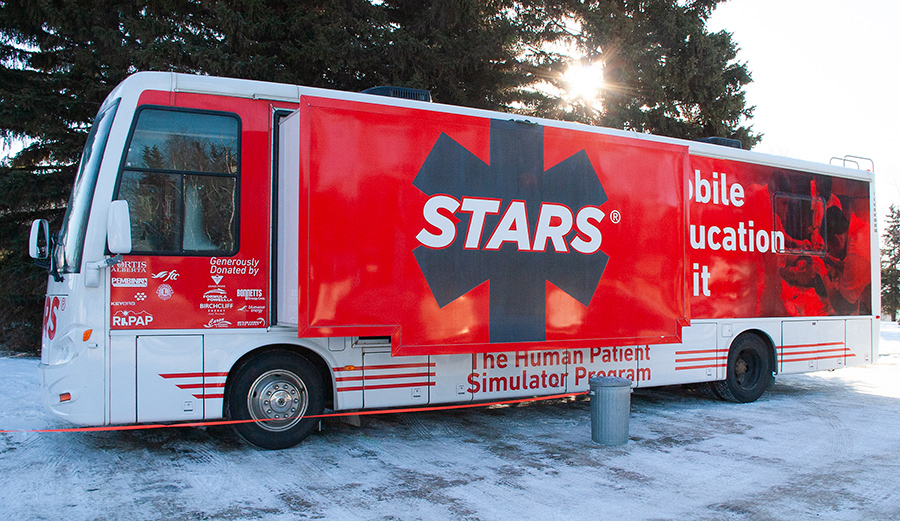
STARS Mobile Education Unit simulates real life trauma for Killarney doctors and nurses
BY KIM LANGEN
Serving as general practitioners in a small rural town keeps our doctors very busy.
And being far from major centres, with their sophisticated medical support – such as the resources available in Brandon or Winnipeg hospitals – means that sometimes traumatic events that occur locally need to be stabilized and dealt with right here in Killarney, before transport.
“We are a rural practice, and emergencies do happen,” said Rachelle Bemment, office manager at the Killarney Medical Centre. “The doctors want to expand their knowledge, and learn to stabilize medical emergencies, trauma, and injuries. They want to try to be the best they can be, and improve their skills.”
So one of our local doctors – Rachelle’s husband Dr. Mark Bemment – decided to crank it up a notch, by inviting the STARS training team to visit our town.
“Mark has been working to educate himself in emergency medicine, and has been training recently in Winnipeg himself with STARS,” said Rachelle Bemment. “He came up with the idea of bringing advanced medical training here to Killarney. We are both excited that they are now coming to us.”
And this past Thursday, a big red bus, the STARS Mobile Education Unit (MEU), rolled into the hospital parking lot to deliver an intense two days of simulator training sessions for the doctors, nurses, and paramedics in the area.
Inside the idling bus was a treatment room, complete with ‘Stan,’ a simulated human, who rested on a gurney, ready to be ‘treated’ by the team of health care providers.
Brent Bekiaris, a flight paramedic with STARS, runs the mobile education program, and together with Alan Mart, a STARS flight nurse, they explained to the doctors and nurses how the simulation training would work.
“Each simulation is around 15 minutes, and we will split up into two groups,” said Bekiaris. “It is a safe and secure place to learn, here inside the bus. And your patient will never die. Alan and I will be here to give you information and cues as you need them.”
For the first simulation of the two-day event, Dr. Bemment, assisted by Dr. Sushma Sudigala, and three nurses, faced the unfolding of a cardiac event inside the bus.
‘Stan’ became Bob the Trucker, who had walked into the hospital with a complaint of chest pain. And he’s left his dog in the truck.
“He can talk, you can hear his respiration, sometimes he can snore; his pupils are reactive to light, he makes heart sounds, bowel sounds, and he has pulses,” said Bekiaris. “He talks and breathes, and his chest rises and falls. You can put fluids into him, you can ask him questions, and he can answer you. You might notice that he sounds kind of like me.”
And as the simulation progresses, led by Dr. Bemment at the helm, it is revealed that Bob is progressing into a heart attack. Plus he’s also worried about leaving his dog unattended.
The health team moves through a series of steps to counteract his demise, using drugs through IV, several monitors, supplying oxygen, and finally to prepare Bob for transport to a major hospital.
And Dr. Bemment also assures Bob that someone will, indeed, take care of his dog.
Once the simulation is over, the entire group re-joined together to discuss the event.
It was rather exciting, very intense, and a great learning experience for the staff at the hospital and medical clinic. Normal clinic hours were maintained, as doctors took it in turns to attend the seminars.
The patient simulations were aimed towards three main trauma and emergency events: cardiac events, such as heart attacks; paediatric emergencies; and hypothermia emergencies.
And the entire teaching program is free to health care providers.
“The MEU program is entirely donor funded, and there is no cost to the community or the health care facilities,” said Chad Saxon, communications lead for Manitoba STARS. “Another terrific aspect of the program is that it allows doctors, nurses, and paramedics to stay in their community for the training, and not potentially leave their communities shorthanded by having to travel to Winnipeg, or other locations.”
The STARS Mobile Education Unit (MEU) was the first mobile program of its kind in North America, and began in 1999 in Alberta, said Saxon.
“We have visited roughly 25 communities in Manitoba,” he added. “Annually we do about 60 outreaches each year. However, due to demand from the community we have brought a second MEU to Manitoba for the next year.”
STARS med-evacs and transfers, conducted via plane and helicopter, occur on occasion at Killarney Airport, and are an important resource in our community. Talented medics like Bekiaris and Mart may well be returning to our town through the airspace – instead of the big red bus.

BOB THE TRUCKER IS IN BIG TROUBLE – Dr. Mark Bemment (left) and Dr. Sushma Sudigala (right) attend human simulant ‘Bob the Trucker,’ who is about to go into cardiac arrest, during the first morning session held on Thursday inside the STARS Mobile Education Unit at the hospital. ‘Bob’ does survive, happily, and is stabilized for transport to a major hospital.

THE TEAM CONVENES – Following the treatment for cardiac emergency patient Bob the Trucker, the two groups of doctors and nurses re-join in the STARS bus, to discuss the intense event with educators Brent Bekiaris (rear, centre), a STARS flight paramedic who also runs the education program, and Alan Mart, a STARS flight nurse.

THE STARS COME TO TOWN – The state-of-the-art Mobile Education Unit for STARS came to town on Thursday, along with a flight paramedic and nurse, to help train local doctors and staff in emergency procedures and protocols. A simulated human served as a patient, presenting in a variety of different scenarios, all right her in the parking lot, just outside of Bayside.
KIM LANGEN/KILLARNEY GUIDE PHOTOS

